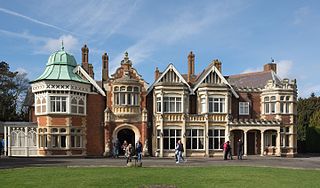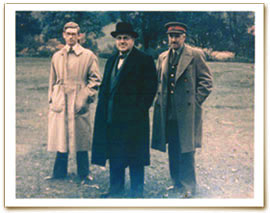Related Research Articles

Bletchley Park is an English country house and estate in Milton Keynes (Buckinghamshire) that became the principal centre of Allied code-breaking during the Second World War. The mansion was constructed during the years following 1883 for the financier and politician Sir Herbert Leon in the Victorian Gothic, Tudor, and Dutch Baroque styles, on the site of older buildings of the same name.

Government Communications Headquarters, commonly known as GCHQ, is an intelligence and security organisation responsible for providing signals intelligence (SIGINT) and information assurance to the government and armed forces of the United Kingdom. Based in "The Doughnut" in the suburbs of Cheltenham, GCHQ is the responsibility of the country's Secretary of State for Foreign and Commonwealth Affairs, but it is not a part of the Foreign Office and its Director ranks as a Permanent Secretary.

William Frederick Friedman was a US Army cryptographer who ran the research division of the Army's Signal Intelligence Service (SIS) in the 1930s, and parts of its follow-on services into the 1950s. In 1940, subordinates of his led by Frank Rowlett broke Japan's PURPLE cipher, thus disclosing Japanese diplomatic secrets before America's entrance into World War II.

The Lorenz SZ40, SZ42a and SZ42b were German rotor stream cipher machines used by the German Army during World War II. They were developed by C. Lorenz AG in Berlin. The model name SZ was derived from Schlüssel-Zusatz, meaning cipher attachment. The instruments implemented a Vernam stream cipher.
Alfred Dillwyn "Dilly" Knox, CMG was a British classics scholar and papyrologist at King's College, Cambridge and a codebreaker. As a member of the Room 40 codebreaking unit he helped decrypt the Zimmermann Telegram which brought the USA into the First World War. He then joined the Government Code and Cypher School (GC&CS).

Sir Francis Harry Hinsley OBE was an English historian and cryptanalyst. He worked at Bletchley Park during the Second World War and wrote widely on the history of international relations and British Intelligence during the Second World War. He was known as Harry Hinsley.
Commander Alexander "Alastair" Guthrie Denniston was a Scottish codebreaker in Room 40, deputy head of the Government Code and Cypher School (GC&CS) and hockey player. Denniston was appointed operational head of GC&CS in 1919 and remained so until February 1942.

Shaun Wylie was a British mathematician and World War II codebreaker.

Rolf Noskwith was a British businessman who during the Second World War worked under Alan Turing as a cryptographer at the Bletchley Park British military base.

The National Museum of Computing is a museum in the United Kingdom dedicated to collecting and restoring historic computer systems. The museum is based in rented premises at Bletchley Park in Milton Keynes, Buckinghamshire and opened in 2007. The building — Block H — was the first purpose-built computer centre in the world, hosting six Colossus computers by the end of World War II.

The Dhaka Metropolitan Police (DMP) is the unit of Bangladesh Police responsible for law enforcement in the metropolis of Dhaka, the national capital and most populous city in Bangladesh. The DMP is the largest police force unit in Bangladesh. At present the DMP commissioner is Md. Shafiqul Islam BPM (Bar).
The Institute of Information Security Professionals (IISP) is an independent, non-profit body governed by its members, with the principal objective of advancing the professionalism of information security practitioners and thereby the professionalism of the industry as a whole.
Harold Bernard Willson was a British linguist and noted academic, who during the Second World War was the first person to decrypt the Italian Navy Hagelin C-38 code machine. He was the father of television presenter and motoring journalist Quentin Willson.
The Secret Intelligence Service (SIS), commonly known as MI6, is the foreign intelligence service of the United Kingdom, tasked mainly with the covert overseas collection and analysis of human intelligence (HUMINT) in support of the UK's national security. SIS is a member of the country's intelligence community and its Chief is directly accountable to the Secretary of State for Foreign and Commonwealth Affairs.
The Government of the United Kingdom maintains intelligence agencies within several different government departments. The agencies are responsible for collecting and producing foreign and domestic intelligence, providing military intelligence, performing espionage and counter-espionage. Their intelligence assessments contribute to the conduct of the foreign relations of the United Kingdom, maintaining the national security of the United Kingdom, military planning and law enforcement in the United Kingdom. The main organisations are the Secret Intelligence Service, the Security Service (MI5), the Government Communications Headquarters (GCHQ) and Defence Intelligence (DI).

Cambridge Analytica Ltd (CA) was a British political consulting firm that came to prominence through the Facebook–Cambridge Analytica data scandal. It was started in 2013 as a subsidiary of the private intelligence company and self-described "global election management agency" SCL Group by long-time SCL executives Nigel Oakes, Alexander Nix and Alexander Oakes, with Nix as CEO. The company had close ties to the Conservative Party (UK), the British royal family and the British military. The firm maintained offices in London, New York City, and Washington, DC. The company closed operations in 2018 in the course of the Facebook–Cambridge Analytica data scandal, although related firms still exist.
The College of National Security was a proposed cyber security school for 16-19 year-olds, scheduled to open in September 2020 at Bletchley Park.
About 8,000 women worked in Bletchley Park, the central site for British cryptanalysts during World War II. Women constituted roughly 75% of the workforce there. While women were overwhelmingly under-represented in high-level work, such as cryptanalysis, they were employed in large numbers in important auxiliary work, such as: operating cryptographic machinery and communications machinery; translating of Axis documents; traffic analysis; clerical duties, and many more besides.
References
- 1 2 "CAMBRIDGE ANALYTICA LTD - Officers (free information from Companies House)". Beta.companieshouse.gov.uk. 30 July 2014. Retrieved 12 December 2016.
- ↑ "IISP announces the appointment of Dr Alastair MacWillson as new Chairman". Iisp.org. 1 April 2011. Retrieved 12 December 2016.[ verification needed ]
- ↑ "Cyber Security Vectors - University of Surrey - Guildford". Surrey.ac.uk. Retrieved 12 December 2016.[ verification needed ]
- ↑ Eleanor Ross. "School for teenage codebreakers to open in Bletchley Park | Technology". The Guardian . Retrieved 12 December 2016.[ verification needed ]
- ↑ "UK's first National College of Cyber Security to open at historic Bletchley Park". Ibtimes.co.uk. 24 November 2016. Retrieved 12 December 2016.[ verification needed ]
- ↑ Tom Mendelsohn (25 November 2016). "Cyber college for wannabe codebreakers planned at UK's iconic Bletchley Park". Ars Technica. Retrieved 12 December 2016.[ verification needed ]
- ↑ Davis, Michelle (17 June 2014). "The Chertoff Group Names Dr. Alastair MacWillson Principle". WashingtonExec.com. Retrieved 12 December 2016.[ verification needed ]
- ↑ "Alastair MacWillson: Executive Profile & Biography". Bloomberg. 30 October 2014. Retrieved 12 December 2016.[ verification needed ]
- ↑ "Cloud Computing: Compliance Challenges". BankInfoSecurity.com. 5 October 2011. Retrieved 12 December 2016.[ verification needed ]
- ↑ MacWillson, Alastair C. (1992). "Hostage-Taking Terrorism". doi:10.1007/978-1-349-12477-0.Cite journal requires
|journal=(help)